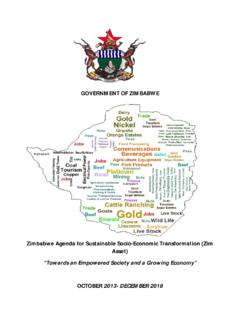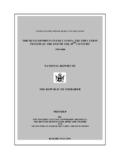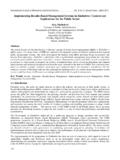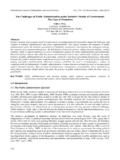Transcription of Zimbabwe Country Assistance Evaluation - OECD
1 Report No. 29058 Zimbabwe Country Assistance Evaluation May 21, 2004 Operations Evaluation Department Document of the World Bank Abbreviations and Acronyms AAA Analytical and Advisory Activities BEAM Basic Education Assistance Module CAS Country Assistance Strategy CAE Country Assistance Evaluation CEM Country Economic Memorandum ESAP Economic and Structural Adjustment Program ESW Economic and Sector Work GDP Gross Domestic
2 Product GNP Gross National Product HIV/AIDS Human Immunodeficiency Virus/Acquired Immune Deficiency Syndrome IDA International Development Association IMF International Monetary Fund LSCS Large Scale Commercial Sector MPSLSW Ministry of Public Service, Labor and Social Welfare OED Operations Evaluation Department PER Public Expenditure Review PPP Purchasing Power Parity SAC Structural Adjustment Credit SDF Social Development Fund STI Sexually Transmitted Infections Director General.
3 Operations Evaluation : Mr. Gregory K. Ingram Director, Operations Evaluation Department : Mr. Ajay Chhibber Senior Manager, OEDCR : Mr. R. Kyle Peters Task Manager : Ms. Poonam Gupta iContents Preface .. iii Summary .. v 1. Background .. 1 Description .. 1 Economic and Social Conditions .. 1 2. Products and Services .. 7 Bank Strategy and Its Relevance .. 7 Implementation of Strategies: Lending.
4 9 Implementation of Strategy: Analytical and Advisory Activities (AAA) .. 15 Resource Mobilization and Aid Coordination .. 18 3. Development Impact of Country Assistance .. 21 Growth and Macroeconomic Stabilization .. 21 Private Sector Development .. 22 Poverty Alleviation .. 23 Overall Assessment .. 24 Counterfactual .. 26 4. Contributors Performance .. 27 World Bank Performance .. 27 Government Performance .. 29 Partner Performance .. 29 Exogenous Factors .. 30 5. Lessons and Recommendations.
5 31 Text Boxes Box : Good Practice: Technical Collaboration and Trust in the Midst of Decline .. 18 Box : Role of IFC and MIGA in Zimbabwe .. 30 Text Tables Table : Social Indicators .. 3 Table : Selected Economic Indicators .. 3 Table : Planned and Actual Lending, FY91 01 .. 10 Table : World Bank Commitments by CAS Period .. 10 Table : OED Ratings (as percent of rated net commitments) .. 14 Table : Zimbabwe : Distribution of Poverty Indexes, 1990 91 and 1995 96 .. 23 Annexes Annex A: Statistical Annex .. 35 Annex B: Recommendations on Land Reform in Bank Reports .. 49 Annex C: Brazil: Land-based Poverty 51 Annex D: User Charges in Health and the Bank s 53 Annex E: Guide to OED s Country Evaluation Rating Methodology.
6 55 iiContents (cont d.) Figure Figure : Zimbabwe Central Government Operations Attachments Attachment A: Management Action Record ..59 Attachment B: Chairman s Summary .. 61 iiiPreface This Country Assistance Evaluation (CAE) provides an independent assessment of the role of World Bank Assistance to the Republic of Zimbabwe during 1990 2000 with reference where relevant to the 1980s. The CAE is a countrywide Evaluation that concentrates on the relevance, efficacy, efficiency, sustainability, and institutional development impact of the Bank's program of Assistance . Section 1 describes Zimbabwe s economic and social developments as well as the major challenges to development.
7 Section 2 evaluates Bank Assistance from the bottom up by assessing the Bank s products and services: strategy, lending, analytical and advisory activities, resource mobilization, and aid coordination. Section 3 evaluates the development impact of Country Assistance . Section 4 discusses the contributors performance, the Bank, the Country and other partners, as well as exogenous influences. Section 5 presents the lessons and recommendations. The CAE is based on Bank strategy and lending documents, economic and sector reports (both formal and informal), Operations Evaluation Department (OED) project assessments, International Monetary Fund (IMF) reports, and interviews with staff of the Bank, government officials and other donors and experts.
8 Non-Bank literature on Zimbabwe was also reviewed. An OED mission visited Zimbabwe from March 24, 2001, to April 10, 2001. A draft of the report was sent to the Zimbabwean Government in January 2003, however comments have not been received. This Evaluation was prepared by Ms. Poonam Gupta (Task Manager), with inputs from Mr. J. W. Van Holst Pellekaan (consultant, OEDCR). Mr. Gene Tidrick (OEDCR) and Mr. Roger Robinson (external) were peer reviewers for the report. Ms. Laurie Effron (OEDCR) also provided comments. Ms. Betty Casely-Hayford and Agnes Santos provided administrative Assistance and Ms. Anar Omarova provided research Assistance . vSummary In the first decade after Independence in April 1980, Zimbabwe sought to promote development and reduce inequities through intensified economic controls and increased social expenditures.
9 This resulted in social progress but at the expense of unsustainable fiscal deficits and low growth. Land distribution remained highly unequal. In 1991 the Government launched an Economic and Structural Adjustment Program (ESAP) to accelerate growth through better fiscal management and market liberalization. This largely failed because of external shocks and unsound policies. Social progress slowed, per capita incomes declined, and the number of people living in extreme poverty increased. AIDS now affects one-third of the adult population and life expectancy has fallen from 56 in 1990 to 40 in 2000. The Bank s strategy in the 1980s responded appropriately to poor economic management but did not provide clear direction to land reform.
10 Lending was concentrated on investment loans for infrastructure. While analytical work appropriately focused on improving economic management, all five major Bank reports made no recommendations on land reform. The Bank provided two structural adjustment credits (SACs) during 1991-96. While a number of important reforms were accomplished through these credits, Zimbabwe was never able to establish macroeconomic stability. Fiscal deficits averaged percent per annum in 1991-99. One reason was the unwillingness of the highest political leadership to make critical adjustments. A second important reason was that financial liberalization and tax reduction were sequenced to come before rather than after reductions in expenditures.


















